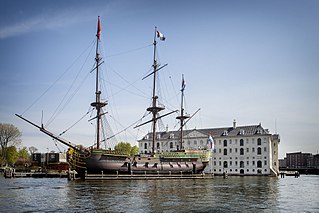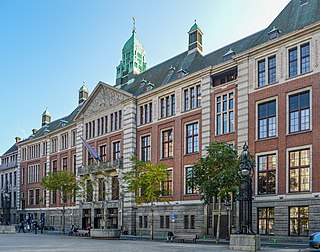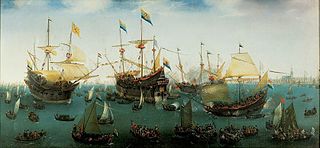
The Dutch East India Company (Dutch : Vereenigde Oostindische Compagnie, often known as VOC) was a chartered company which issued a considerable series of coinage in bronze, silver and gold for its territories in the Far East between 1602 and 1799.

The Dutch East India Company (Dutch : Vereenigde Oostindische Compagnie, often known as VOC) was a chartered company which issued a considerable series of coinage in bronze, silver and gold for its territories in the Far East between 1602 and 1799.
The Dutch East India Company (VOC) was established as a chartered company in 1602 and was designed to replace a number of earlier Dutch trading companies. [1] To prevent the constant infighting between rival companies, the Dutch States-General gave the company officially recognised status and allowed it fulfill some functions usually reserved for a state. The company's charter allowed it to have its own military forces, make treaties, and coin its own money. [1] It was given full powers to act between the Cape of Good Hope and the Straits of Magellan. [1] The company grew rapidly, founding towns and colonies at Cape Town, Batavia (modern Jakarta), and elsewhere. [1]
During the 200 years of its existence, VOC issued large quantities and many different patterns of coins. [2] Writers on the subject distinguish between the types produced in the Netherlands for the company and those issued by it locally in Asia. [2] Both types often circulated together, but European coins were more common in some areas than others. [2] Most coins issued for the company carried its distinctive monogram of the interlocked letters "VOC". [3] The most common denominations were the Guilder, Ducatoon, Stiver (or Stuiver) and Doit (Duit). Some fractions, like the Half-Doit, were also produced.
Coins were issued in the Netherlands during the mid-17th century and again from 1744 until its dissolution. [2] Coins were struck in gold, silver, bronze and, unusually, pewter. [2] They were issued by the local mints of the Netherlands, including Holland, Utrecht, Zeeland, Gelderland and Overijssel. [4]
The locally produced coins in Asia display more variation and were produced in gold, silver and bronze. [3] Countermarks are sometimes seen on these coins, either stamped by the company or by local private individuals. [5] Foreign coins, including Japanese Koban or Surat rupees, were sometimes countermarked by the company for its own use. [6]

The Dutch West India Company or WICDutch pronunciation: [ʋɛstˈɪndisəkɔmpɑˈɲi] was a chartered company of Dutch merchants as well as foreign investors, formally known as GWC. Among its founders were Reynier Pauw, Willem Usselincx (1567–1647) and Jessé de Forest (1576–1624). On 3 June 1621, it was granted a charter for a trade monopoly in the Dutch West Indies by the Republic of the Seven United Netherlands and given jurisdiction over Dutch participation in the Atlantic slave trade, Brazil, the Caribbean, and North America.

The Amsterdam was an 18th-century cargo ship of the Dutch East India Company. The VOC was established in 1602. The ship started its maiden voyage from Texel to Batavia on 8 January 1749, but was wrecked in a storm on the English Channel on 26 January 1749. The shipwreck was discovered in 1969 in the bay of Bulverhythe, near Hastings on the English south coast, and is sometimes visible during low tides. The location in 1969 was found by Bill Young, the site agent/project manager for the sewage outfall being built by the William Press Group. With time on his hands during the long stay away from home, he followed up the rumour of the going aground. He was castigated by the Museum of London for scooping out the interior of the bow with a digger as it could have led to the structure collapsing. However, it uncovered the initial items which led to a more extensive excavation of the cargo which reflected life at the time. The wreck is a Protected Wreck managed by Historic England. Some of the findings from the site are in The Shipwreck Museum in Hastings. A replica of the ship is on display in Amsterdam.

The United East India Company was a chartered company established on 20 March 1602 by the States General of the Netherlands amalgamating existing companies into the first joint-stock company in the world, granting it a 21-year monopoly to carry out trade activities in Asia. Shares in the company could be bought by any resident of the United Provinces and then subsequently bought and sold in open-air secondary markets. It is sometimes considered to have been the first multinational corporation. It was a powerful company, possessing quasi-governmental powers, including the ability to wage war, imprison and execute convicts, negotiate treaties, strike its own coins, and establish colonies.

The French East India Company was a joint-stock company founded in France on 1 September 1664 to compete with the English and Dutch trading companies in the East Indies. Planned by Jean-Baptiste Colbert, it was chartered by King Louis XIV for the purpose of trading in the Eastern Hemisphere. It resulted from the fusion of three earlier companies, the 1660 Compagnie de Chine, the Compagnie d'Orient and Compagnie de Madagascar. The first Director General for the Company was François de la Faye, who was adjoined by two Directors belonging to the two most successful trading organizations at that time: François Caron, who had spent 30 years working for the Dutch East India Company, including more than 20 years in Japan, and Marcara Avanchintz, an Armenian trader from Isfahan, Persia.

The Dutch colonial empire comprised the overseas territories and trading posts controlled and administered by Dutch chartered companies—mainly the Dutch East India Company and the Dutch West India Company—and subsequently by the Dutch Republic (1581–1795), and by the modern Kingdom of the Netherlands after 1815. It was initially a trade-based system which derived most of its influence from merchant enterprise and from Dutch control of international maritime shipping routes through strategically placed outposts, rather than from expansive territorial ventures. The Dutch were among the earliest empire-builders of Europe, following Spain and Portugal and one of the wealthiest nations of that time.

Euronext Amsterdam is a stock exchange based in Amsterdam, the Netherlands. Formerly known as the Amsterdam Stock Exchange, it merged on 22 September 2000 with the Brussels Stock Exchange and the Paris Stock Exchange to form Euronext. The registered office of Euronext, itself incorporated in the Netherlands a public limited company, is also located in the exchange.

The duit is an old Dutch copper coin. It was manufactured in the territory of the Dutch Republic and became later an international currency. Its value was 1/8 stuiver.

The rijksdaalder was a Dutch coin first issued by the Republic of the Seven United Netherlands in the late 16th century during the Dutch Revolt which featured an armored half bust of William the Silent. It was the Dutch counterpart of the Reichsthaler of the Holy Roman Empire but weighed slightly less, at 29.03 g of 0.885 fine silver, reduced to 0.875 fine by the 17th century. Friesland, Gelderland, Holland, Kampen, Overijssel, Utrecht, West Friesland, Zeeland, and Zwolle minted armored half bust rijksdaalders until the end of the 17th century.

The Netherlands Indiesgulden was the unit of account of the Dutch East Indies from 1602 under the United East India Company, following Dutch practice first adopted in the 15th century. A variety of Dutch, Spanish and Asian coins were in official and common usage. After the collapse of the VOC at the end of the 18th century, control of the islands reverted to the Dutch government, which issued silver 'Netherlands Indies' gulden and fractional silver and copper coins until Indonesian independence in 1945.

Dutch India consisted of the settlements and trading posts of the Dutch East India Company on the Indian subcontinent. It is only used as a geographical definition, as there was never a political authority ruling all Dutch India. Instead, Dutch India was divided into the governorates Dutch Ceylon and Dutch Coromandel, the commandment Dutch Malabar, and the directorates Dutch Bengal and Dutch Suratte.

The Dutch–Portuguese War was a global armed conflict involving Dutch forces, in the form of the Dutch East India Company, the Dutch West India Company, and their allies, against the Iberian Union, and after 1640, the Portuguese Empire. Beginning in 1598, the conflict primarily involved the Dutch companies and fleet invading Portuguese colonies in the Americas, Africa, and the East Indies. The war can be thought of as an extension of the Eighty Years' War being fought in Europe at the time between Spain and the Netherlands, as Portugal was in a dynastic union with Spain after the War of the Portuguese Succession, for most of the conflict.

The Bank of Amsterdam was an early bank, vouched for by the city of Amsterdam, and established in 1609. It was the first public bank to offer accounts not directly convertible to coin. As such, it has been described as the first true central bank, even though that view is not uniformly shared and a similar claim has been made for the Taula de canvi de Barcelona, established two centuries earlier.

The Dutch Empire is a term comprising different territories that were controlled by the Netherlands from the 17th to 20th centuries. They settled outside Europe with skills in trade and transport. In the late 16th century, the Netherlands reclaimed their lead at sea, and by the second half of the 17th century, dominated it. This hundred-year period is called the Dutch Golden Age. The Dutch built their empire with corporate colonialism by establishing the Dutch East India Company (VOC) and the Dutch West India Company (GWC), following Britain's footsteps, which led to war between both empires. After the French Revolutionary Wars, the Netherlands lost most of its power to the British after the French armies invaded the Netherlands and parts of the Dutch colonies. Hence, Dutch leaders had to defend their colonies and homeland. Between 1795 and 1814, the French restored the VOC in Indonesia and Suriname which remained under Dutch control.

Company rule in the Dutch East Indies began when the Dutch East India Company appointed the first governor-general of the Dutch East Indies in 1610, and ended in 1800 when the bankrupt company was dissolved and its possessions were nationalized as the Dutch East Indies. By then it exerted territorial control over much of the archipelago, most notably on Java.

Isaac Le Maire was a Walloon-born entrepreneur, investor, and a sizeable shareholder of the Dutch East India Company (VOC). He is best known for his constant strife with the VOC, which ultimately led to the discovery of Cape Horn.

The Cape Colony was a Dutch United East India Company (VOC) colony in Southern Africa, centered on the Cape of Good Hope, from where it derived its name. The original colony and its successive states that the colony was incorporated into occupied much of modern South Africa. Between 1652 and 1691, it was a Commandment, and between 1691 and 1795, a Governorate of the United East India Company (VOC). Jan van Riebeeck established the colony as a re-supply and layover port for vessels of the VOC trading with Asia. The Cape came under VOC rule from 1652 to 1795 and from 1803 to 1806 was ruled by the Batavian Republic. Much to the dismay of the shareholders of the VOC, who focused primarily on making profits from the Asian trade, the colony rapidly expanded into a settler colony in the years after its founding.

The economic history of Indonesia is shaped by its geographic location, its natural resources, as well as its people that inhabited the archipelago that today formed the modern nation-state of the Republic of Indonesia. The foreign contact and international trade with foreign counterparts had also shaped and sealed the fate of Indonesian archipelago, as Indians, Chinese, Arabs, and eventually European traders reached the archipelago during the Age of Exploration and participated in the spice trade, war and conquest.

A voorcompagnie (pre-company) is the name given to trading companies from the Republic of the Seven United Netherlands that traded in Asia between 1594 and 1602, before they merged to form the Dutch East India Company (VOC). The pre-companies were financed by merchants from the Northern Netherlands and rich immigrants from the Southern Netherlands. Because of the deadly competition, the government forced the smaller trading companies to unite and form the (United) East India Company. In its turn, it received the exclusive rights for the trade with Asia for the following 21 years.

The Veerse Compagnie was a pre-company from the Republic of the Seven United Netherlands that was founded by Balthazar de Moucheron, a ship owner from Antwerp in the Southern Netherlands. After the fall of Antwerp he moved his business to Zeeland. The fleet of the Veerse Compagnie was made up of two ships; 'Leeuw' (Lion) and 'Leeuwin' (Lioness) and was headed by Cornelis Houtman. Its fleet left from Veere on 28 March 1598 and returned to the Republic of the Seven United Netherlands in 1600.

The Palembang pitis was a currency issued by the Palembang Sultanate from the 1600s until 1825 when the sultanate was dissolved and its territory taken over by the colonial government of the Dutch East Indies. The currency consisted of low denomination tin alloy coins which were mostly traded in bulk. Due to the lack of a centralized mint, the pitis often had inconsistent manufacture and were frequently counterfeited.